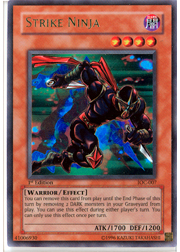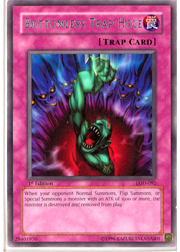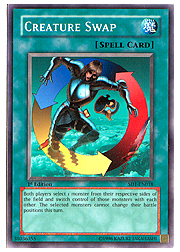Strike Ninja is an interesting card. Its effect is simple to figure out, but as soon as you begin to combine it with other cards, everything hits the fan. What happens if you take your opponent’s Strike Ninja with Snatch Steal and then use its effect? What about after Creature Swap? Can Strike Ninja use its effect multiple times?
Strike Ninja
 For quick reference, here is the text of Strike Ninja from its printing in Dark Revelations 2. “You can remove this card from play until the End Phase of this turn by removing from play 2 DARK monsters in your Graveyard. You can use this effect during either player's turn. You can only use this effect once per turn.”
For quick reference, here is the text of Strike Ninja from its printing in Dark Revelations 2. “You can remove this card from play until the End Phase of this turn by removing from play 2 DARK monsters in your Graveyard. You can use this effect during either player's turn. You can only use this effect once per turn.”
In order to activate Strike Ninja’s effect, you will need to have at least two Dark-attribute monsters in your graveyard that you can remove from play. These two Dark-attribute monsters you remove from play are used to pay the cost of activating Strike Ninja’s effect. Knowing this, you should keep in mind that it won’t be possible for you or your opponent to respond in a chain and target those monsters.
When Strike Ninja’s effect resolves, it removes itself from play and remains there until the end phase of the turn. When the end phase arrives, Strike Ninja returns to the field under control of the player that activated its effect, and is placed onto his or her side of the field in the battle position of that player’s choice.
It’s important to note that Strike Ninja’s return to play is not a special summon. This means your opponent will not be able to use a card like Torrential Tribute or Bottomless Trap Hole to destroy the Ninja when it returns. You can also still activate Scapegoat during the same turn you use its effect and not have to worry about losing your Strike Ninja. Of course, the Ninja will need a space in which to return, so make sure that you have one available.
The Quick Escape
Strike Ninja is part of a small selection of monsters that have the “multi-trigger effect,” making its effect spell speed 2. This gives the Ninja the ability to use its effect in order to avoid a bad situation.
Example: Dodging the Bottomless Hole
Danielle, the turn player, normal summons her Strike Ninja. Her opponent, Sam, responds to the summon with Bottomless Trap Hole. Thanks to Strike Ninja’s multi-trigger effect, Danielle can activate Strike Ninja’s effect and chain it to that of Bottomless Trap Hole. The chain forms as follows:
Bottomless Trap Hole à Strike Ninja
 When the chain resolves, Strike Ninja’s effect resolves first and removes the Ninja from play. Sam’s Bottomless Trap Hole then tries to resolve, but its effect cannot destroy Strike Ninja, since it’s already been removed from play.
When the chain resolves, Strike Ninja’s effect resolves first and removes the Ninja from play. Sam’s Bottomless Trap Hole then tries to resolve, but its effect cannot destroy Strike Ninja, since it’s already been removed from play.
Since Strike Ninja’s effect is spell speed 2, it’s possible for your opponent to respond to the effect with their own spell speed 2 effect. They could even step up to spell speed 3, if he or she uses Divine Wrath. If your opponent uses a spell speed 2 effect, and you still have at least two Dark-attribute monsters in your graveyard, you'll probably want to use Strike Ninja's effect again. Unfortuantely, this is not possible because you cannot activate Strike Ninja's effect more then once during the same turn.
If your opponent manages to get an effect onto the chain after you have activated Strike Ninja's effect, that effect could remove your Strike Ninja from the field and prevent its effect from resolving properly. Let’s go back to our example with Bottomless Trap Hole. If Sam responds to Strike Ninja’s effect with a card like Ring of Destruction and Danielle cannot afford to use Strike Ninja’s effect again, we get the following chain:
Bottomless Trap Hole à Strike Ninja à Ring of Destruction
Ring of Destruction will resolve first and destroy Strike Ninja. This will place it in the graveyard before its effect can resolve, preventing it from removing itself from play.
Given Strike Ninja’s ability to get itself out of harm’s way, your opponent could be forced to make a difficult decision. He or she can use a removal card and force you to activate Strike Ninja’s effect in order to preserve it, or he or she will have to abandon the use of their removal cards and find another way to combat the Ninja. This could mean relying on stronger monsters to get the job done.
When your opponent proceeds to attack your Strike Ninja with that stronger monster, you will be the one who’s faced with the difficult decision. Since it is your opponent’s battle phase, using Strike Ninja’s effect to remove it from play will result in a replay. If Strike Ninja was your only monster, you’ll be wide open when your opponent gets to redefine his or her attack.
One last important note on combat with Strike Ninja—you cannot activate Strike Ninja’s effect during the damage step. If you attack an opponent’s face down monster with your Strike Ninja and that monster turns out to be D. D. Warrior or D. D. Warrior Lady, you will not be able to use Strike Ninja’s effect to avoid the D. D. monster’s effect. The effects of D. D. Warrior and D. D. Warrior Lady activate and resolve during the damage step, and that’s far too late for Strike Ninja.
Ninja Exchange Program
 Remember that the player who uses Strike Ninja’s effect is the player to whom it will return during the end phase. This doesn’t necessarily mean that Strike Ninja will remain there for all time, though. If you were to use Creature Swap to obtain your opponent’s Strike Ninja and then use its effect after you receive it, when it returns to your side of the field during the end phase, it will remain under your control. The same cannot be said for other, temporary control exchanges.
Remember that the player who uses Strike Ninja’s effect is the player to whom it will return during the end phase. This doesn’t necessarily mean that Strike Ninja will remain there for all time, though. If you were to use Creature Swap to obtain your opponent’s Strike Ninja and then use its effect after you receive it, when it returns to your side of the field during the end phase, it will remain under your control. The same cannot be said for other, temporary control exchanges.
Example: Ninja Theft
Augie activates Snatch Steal and takes control of Bonnie’s Strike Ninja. He declares an attack with it, but Bonnie activates Sakuretsu Armor. Augie decides to activate Strike Ninja’s effect to save it from being destroyed. This removes Strike Ninja from play, destroying Snatch Steal in the process. During the end phase, Strike Ninja returns to Augie’s side of the field, but since it’s no longer equipped with Snatch Steal, it returns to Bonnie, its previous controller. Bonnie will now retain control of Strike Ninja.
The same is true for Brain Control and other similar cards. If Augie takes Strike Ninja with Brain Control and uses its effect after gaining control of it, it will return to his side of the field during the end phase, but then during that same end phase, it will return to its previous controller.
Ninja with Chain
As evidenced by our scenario with Snatch Steal, when Strike Ninja removes itself from play, any cards it’s equipped with are destroyed. It’s important to remember that the equip card is not being destroyed by Strike Ninja’s effect. The equip card is actually being destroyed by a game mechanic. This isn’t a matter of any concern for most equip cards, but it does need to be remembered when we’re dealing with one special trap card, Blast with Chain.
Blast with Chain has an effect that allows its controller to destroy a card on the opponent’s side of the field if Blast with Chain is destroyed by a card effect while equipped to a monster. In the case of Strike Ninja, that does not occur.
While it’s true that the result of Strike Ninja’s effect leads to Blast with Chain’s destruction, you need to remember that Blast with Chain is only being destroyed because the monster it is equipped to has left the field. It’s being destroyed by a game mechanic and not by a card’s effect, and thus it will not allow you to destroy a card on your opponent’s side of the field.
Until next time, send all comments, suggestions, and observations to Curtis@metagame.com.